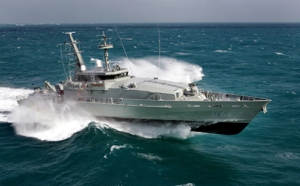In a previous entry we discussed safety at ports during a riot, a phenomenon that unfortunately grows more common in the modern geo-political scenario as industries conflict with interest of employees and the local populous. However, this article will try to discuss another danger in the maritime sector; oil rig safety.
Oil rigs are important structures which contribute to the oil imports and exports which then augment economy of a party owning the rig; painting a target on itself for potential attacks from pirates to terrorists. Firstly, ever since September 11 attacks, the perception of oil rigs has changed since they are usually present in waters bordering different nations therefore also making such installations from gas to oil rigs a strategic asset in an external assault from aforementioned parties. Along with this, the installations would also become targets for the fact that they contribute to resource and energy sectors of a certain nation; opening opportunities for ransom.
Beginning the analysis of possible threats on offshore installations it is worth mentioning that most people, usually un-initiated in the maritime or security field make a mistake of labeling all threats to rigs as “terrorist” which not only obscures other threats but misleads some security agencies into thinking that terrorism is the most serious threats thus crippling the installation defenses in favour of a less common threat as more investments were made on pacifying oceans with patrol boats and specialised squads.
The first ever documented offshore installation attacks dates back to August 1899 in Santa Barbara, California; followed by more attacks in the future. However, the parties that carried out said attacks were not terrorists (though a few attacks were by them) but pirates, criminal syndicates and environmental activists; presenting more scenarios for a possible attack. Parties that also may attack the installations in the modern day are vandals, insurgents, civil protests and inter-state hostilities alongside internal sabotage.
Terrorism and piracy are more obvious than the alternative threats to offshore installations where insurgency is motivated by political instability where insurgent groups cause destruction to relay their message. Insurgents also rally global support with their attacks as the media is always eager to cover a disaster. Example of this is the attack by Movement of Emancipation of Niger Delta/MEND group on the offshore oil platform in the Niger Delta region with aims to evenly distribute oil profits and compensations from responsible companies.
Organised crime, very different from terrorism as the goal is not to instill fear but profit from the activity and protect said profit in advance; reaching both by exploitation and manipulation of an existing system. This threat is commonly theft and extortion which then reflects on the oil industry itself. Another part of organised crime is “protection tax” which perpetrators instill. Armed robbery also happens when rigs get boarded by a group who has specific targets or quotas to meet such as stealing certain goods from stores.
However, not all threats originate from radical groups as they have counterparts who give less focus on gain and more on relaying a message. Enter civil protests that are done by environmental, labour activist groups and occasionally striking workers or anti-government lobbyists; targeting operations over the installation itself. Threats include un-authorised boarding of operating vehicles and the platform itself. Vandalism is another issue in offshore installation where cargo and its containers, supporting equipment, infrastructure and system facilities; prominent among activists.
Oil platforms are placed mostly in international waters therefore occasionally sparking inter-state conflicts which add another threat to the mix. Whether it was the attack on the Iranian oil platform by Iraqi air force jets in 1983 or attack on another Iranian oil platform by the US military 1988; both were related to international hostilities. A more modern example is the Chinese oil exploration in disputed waters near Vietnam; triggering disputes and anti-Chinese sentiments inside Vietnam.
Finally, there is the threat of internal sabotage which is arguably the worst threat since its the most un-expected. Along with this, the main threat are the employees themselves; whether being unsatisfied with their working conditions or their salary or anything else which relates to their job. Occasionally, employees that are either unsatisfied or terminated can collude with terrorists, pirates or other aforementioned threats.
Terrorism and piracy is the most obvious and visible threats to offshore installations with motivations are relatively more clear and, judging by the time and resources invested into counter-measures, an easier threat to address. Therefore, other factors aside from repelling a full-frontal attack will be discussed below.
Firstly, the location of the installation itself is important, preferably before establishing it in a certain area where the installation’s security depends on the local stability in the geo-political sense. Attacks themselves are motivated mostly by profit and religious/political motivations but attackers rarely state their objectives. However, a possible theory is to gain resource control as well as revenues from sales of said resource.
Finally, it is also important to discuss tactics for the attacks since times had changed and possible weapons, including military-grade ones are unfortunately more easily accessible. Therefore warranting a more focused approach with that fact in mind.


